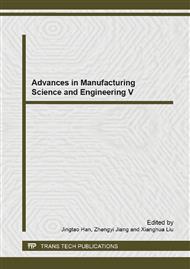p.680
p.684
p.690
p.696
p.703
p.707
p.711
p.717
p.725
Experiment for Vibration Suppression Based on Particle Damping for Gear Transmission
Abstract:
Introducing the particle damping technology into the gear transmission will effectively reduce the vibration during gear engagement, especially suitable for high temperature, oil-lubricating environment for the gear transmission system. In the real working situation, centrifugal load will make the particle at one end away from the rotation center. The vibration suppression of particle damping in the gear transmission is studied through experimental method. The effect of rotation speed and particle filling rate on vibration suppression of particle damping is analyzed in gear transmission. The result will provide exact theory basis and design principle for the vibration suppression of gear transmission.
Info:
Periodical:
Pages:
703-706
Citation:
Online since:
June 2014
Authors:
Price:
Сopyright:
© 2014 Trans Tech Publications Ltd. All Rights Reserved
Share:
Citation:


